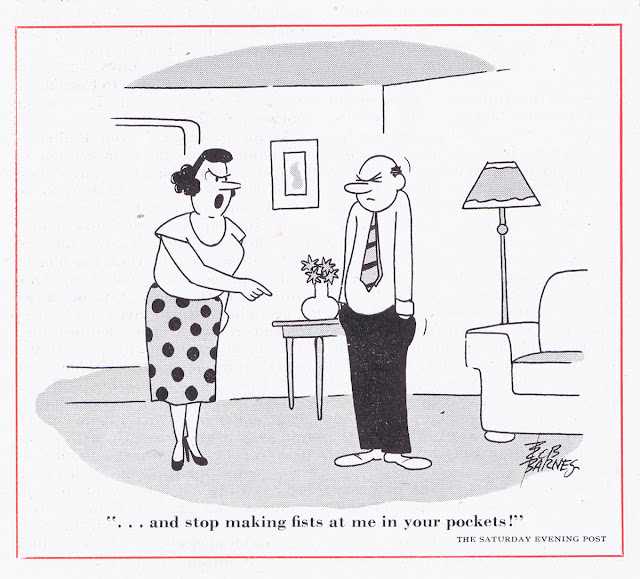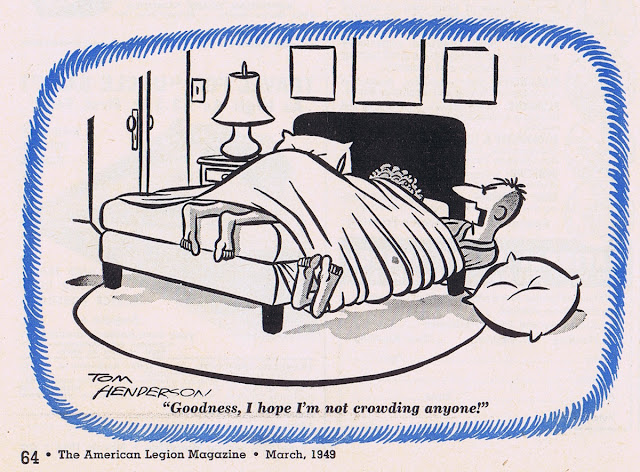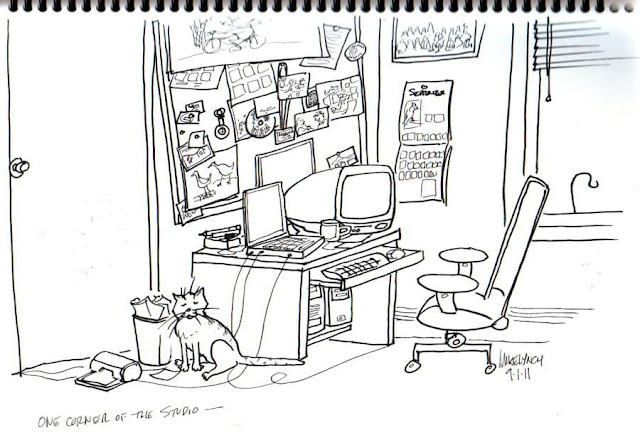Marriage is a sacred institution, its vows meant to be taken solemnly. Unless you're talking cartoons. In cartoons the husband is a lazyboned dope and the wife a shopaholic nag. You know what I mean. Dick Buchanan has 26 classic golden age magazine cartoons that get this point across succinctly. Thanks so much, and take it away, Dick:
---
THE SEARCH FOR HAPPINESS
Part Three: MARRIAGE
(1946 – 1967)
JOHN DEMPSEY. Look Magazine June 6, 1961.
This is the third, and final, installment of The Search for Happiness—Marriage.
The first thing one must know about marriage in mid-20th century is that most couples didn’t believe in divorce. They preferred a fight to the finish.
The cartoons selected here clearly illustrate the haps and mis-haps of marriage as seen through gag cartoons. The husband, known in those days as “The Provider,” was often a lazy bum who spent most of his free time lying on the couch napping or watching TV while drinking beer. When he wasn’t home he was drinking and/or playing poker with his buddies he was fishing hunting or playing golf. The wife was the “homemaker,” usually a bird-brain who spent her time shopping for clothes and along the way, wrecking the car in her guise as the dreaded Woman Driver. Her spare time was spent brow-beating her poor husband, often assisted by her monstrous mother.
It is only fair to acknowledge the dark side of marital bliss -- spousal abuse. Many cartoons highlighted this topic. The wife was the abuser in 99% of the cartoons while the majority of readers of the leading national weekly magazines were women. Go figure.
So, for better or worse, for richer or poorer, winner take all, here’s the last stop in The Search for Happiness . . . Marriage.
1. BILL HARRISON. American Magazine April, 1955.
2. EDWIN LEPPER. The Saturday Evening Post October 17, 1953.
3. TOM HUDSON. True Magazine February, 1949.
4. BOB BARNES. The Saturday Evening Post October 3, 1953.
5. JEFF KEATE. Liberty Magazine November 30, 1946.
6. VIRGIL PARTCH. American Legion Magazine March, 1947.
7. TOM HENDERSON. American Legion Magazine March, 1949.
8. HERB WILLIAMS. True Magazine January, 1967.
9. IRWIN CAPLAN. The Saturday Evening Post June 12, 1949.
10. SYDNEY HOFF. The Saturday Evening Post June 11, 1949.
11. WILLIAM F. BROWN. 1000 Jokes Magazine December, 1955 – February, 1956.
12. JERRY MARCUS. The Saturday Evening Post April 18, 1953.
13. LEW FOLLETTE. The Saturday Evening Post November 5, 1949.
14. HERB GREEN. Laugh Parade May, 1967.
15. SALO ROTH. Liberty Magazine November 30, 1946.
16. WALTER GOLDSTEIN. The Saturday Evening Post June 11, 1960.
17. HANK KETCHAM. This Week Magazine August 21, 1949.
18. STAN HUNT. The Saturday Evening Post October 10, 1953.
19. DICK CAVALLI. Collier’s April 27, 1956.
20. STEVE DUQUETTE. American Legion Magazine July, 1963.
21. RALSTON JONES. The Saturday Evening Post October 30, 1954.
22. LAFE LOCKE. American Legion Magazine September, 1951.
23. GARRETT PRICE. Collier’s November 2, 1946.
24. ROWLAND WILSON. 1000 Jokes Magazine Spring, 1954.
25. MARTHA BLANCHARD. The Saturday Evening Post June 15, 1957.
This is the third Search For Happiness. Want more searching? OK! The other two are:
From the Dick Buchanan Files: The Search for Happiness Part One: The Mating Game 1949 - 1959
From the Dick Buchanan Files: The Search for Happiness Part Two: Here Comes the Bride! 1942 - 1964



























































